Ignite: How speakers prepare
I’m a huge fan of helping people speak – I’m the speaker coach for Ignite Seattle, and did an Ignite talk called How and Why to Speak at Ignite hoping to get more people up on stage. Many events now use this short video, an ignite talk about doing good ignite talks, to help get people interested and psyched to participate.
In the “things I promised but never got around to” department”, before my book Confessions of a Public Speaker came out, I surveyed everyone and their mother about their experiences speaking in short format form, like Ignite or Pecha Kucha (5 or 6 minute talks with automated slide decks – see the end of boring presentations on forbes.com). About 150 people responded and here are the results.
I offered two $100 amazon gift certificates, and the winners have been notified via email.
Top line summary:
- ~40% of speakers spend at least 6 hours preparing – this is roughly one minute of effort for each second of the actual ignite talk.
- 55% of speakers found Ignite harder than regular speaking
- Yet 90% felt the audiences are better or about the same than regular events
- Most speakers are in their 30s and are men (~80/20 gender breakdown) (Ignite has strong tech influences, and this breakdown likely reflects the tech industry rather than any bias among organizers)
- And an amazing 98% of all speakers were glad they spoke at Ignite
Here are the charts with some additional commentary:
1. How old are you?
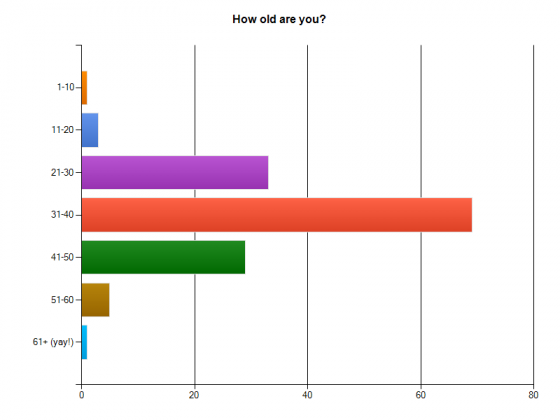
I suspect this breakdown maps exactly to the primary professions and affiliations of those who speak at Ignite. If you took the age breakdown for the tech sector, and those interested in arts, music and DIY, it’d look nearly the same. It also reflects the age breakdown of the original organizers and volunteers pretty well.
2. What is your gender?
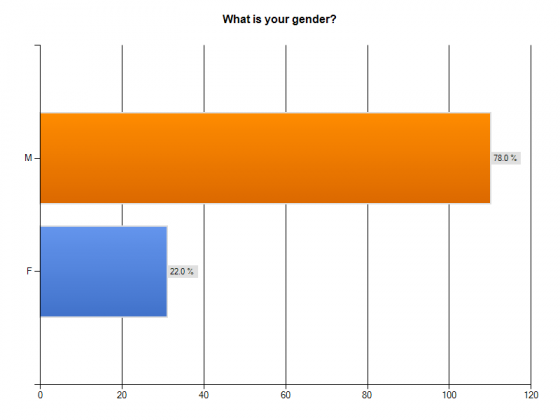
I’d be curious to know how much this reflects the audience gender breakdown. I think it’s pretty close. Not that this is good, but that there is a feedback loop that’s hard to break: to get more diverse speakers is easier if there is a more diverse audience, and vice-versa.
This is also averaged across all Ignite venues that reported, and each city and organizer will have varying interest and success in how well they pick speakers.
3. How much experience do you have?
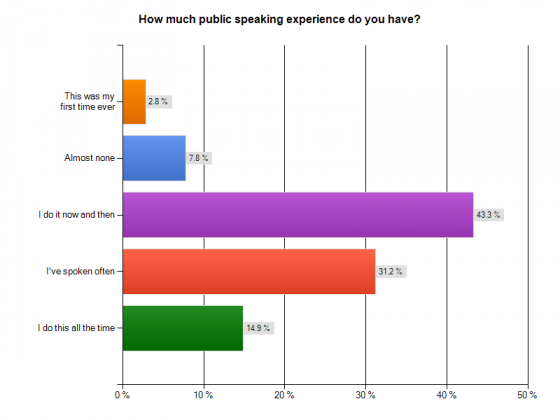
Most of the speakers are not particularly experienced. More than 50% are occasional speakers or have almost no experience at all. This is a fantastic number – ignite might be effective at giving visibility to people who don’t often get it or aren’t usually attracted to the stage.
4. Did you find ignite easier or harder than other public speaking?
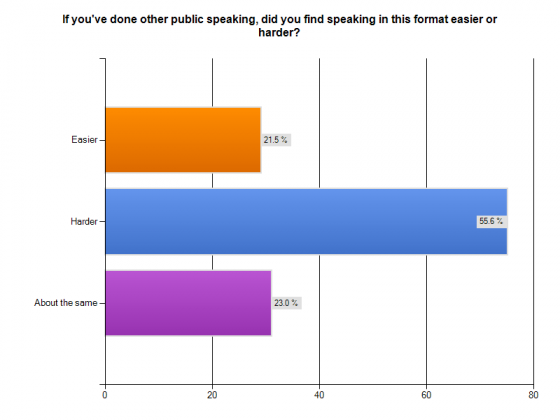
Many people reported the challenge of no control over the slides was entirely new, as was speaking with a strict time limit. They’d never done either before and this was unexpectedly difficult to get used to. Most people reported it took much more effort than they expected to work within shorter time limits, and it demanded that they practice, which was a new experience for many.
5. Was the audience easier or harder to work with than other audiences?
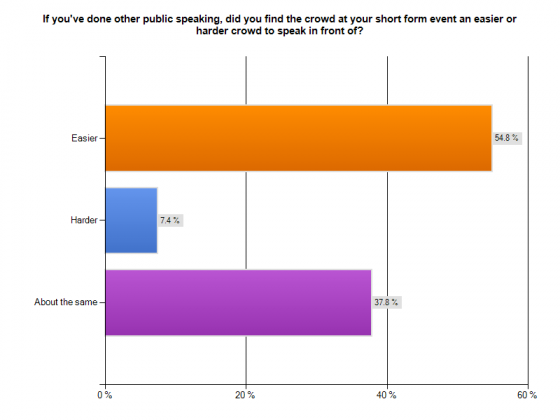
Despite the format being harder, there was strong evidence the crowds are much more positive and supportive than in general. Part of this could be the social nature of ignite events (they are held after work, are often free, have bars serving alcohol, etc.), as well as people’s empathy for the special challenges they know the speakers must face.
6. How much total time did you spend preparing?
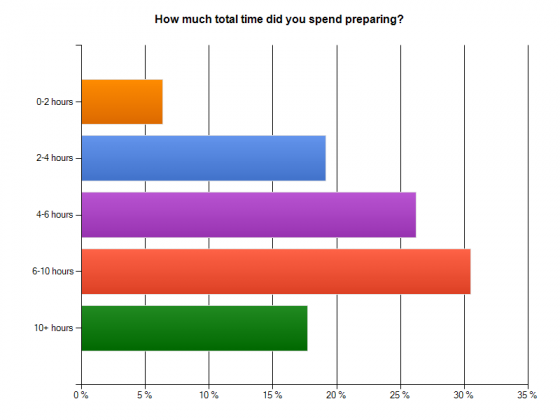
It’s surprising to see this, but it does take time to get the sequence and content of slide right, even if only for five minutes. TV commercials are only 30 seconds long, but can be harder to produce than longer formats for similiar reasons. Every second or slide counts.
7. How many times did you practice the talk?
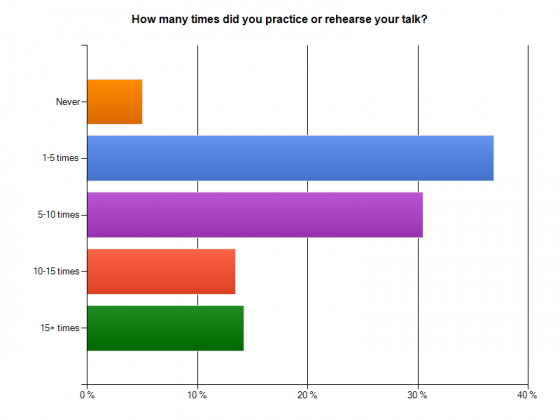
The relatively low rehearsal counts suggests people spend a great deal of time making their slides without practicing. Based on my research, this is definitely a mistake. More rehearsals, even with only half baked slides, will increase the speakers sense of what the slides need to do, and allow them to work faster in producing their material.
8. Are you glad you spoke in this format?
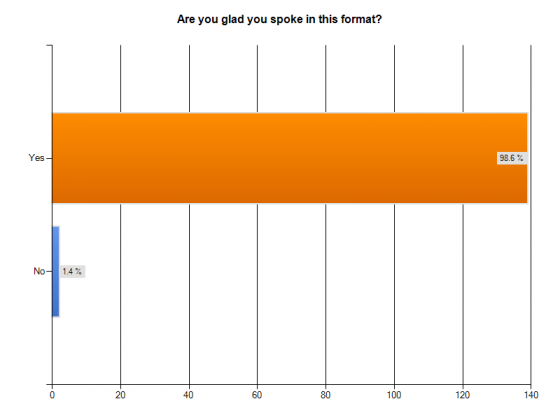
What an amazing chart. Speaks for itself.
Many people reported that ordinary public speaking seemed much easier by comparison, that they got great feedback from people in the audience, and had more confidence afterward in their any public speaking activity than they had before.
The strongest complaint in the 1.4% were hostile audiences – something uncommon at most ignite events, but with a tough crowd there’s much less a speaker can do given they’ve rehearsed in order to be slaves to the slides.
Data details:
- This survey was conducted using surveymonkey in late 2009.
- I used this blog, my mailing list and the help of several ignite groups to spread the word. Special thanks to Brady Forrest and The Ignite Seattle crew (Justin Martinstein, Randy Stewart, Brian Dorsey, Stuart Maxwell and Brian Zug) for all their support over the years.
- I contacted the Pecha-Kucha folks, who offered to help, but despite many requests did not pass my survey onto their mailing lists – Thus, of the 150 respondents 90+% were ignite veterans.
- There is a growing movement afoot for short form public speaking: read this for more.
If you’re interested in being a better speaker, check out my bestselling book, Confessions of a Public Speaker. Grab a free chapter here.
